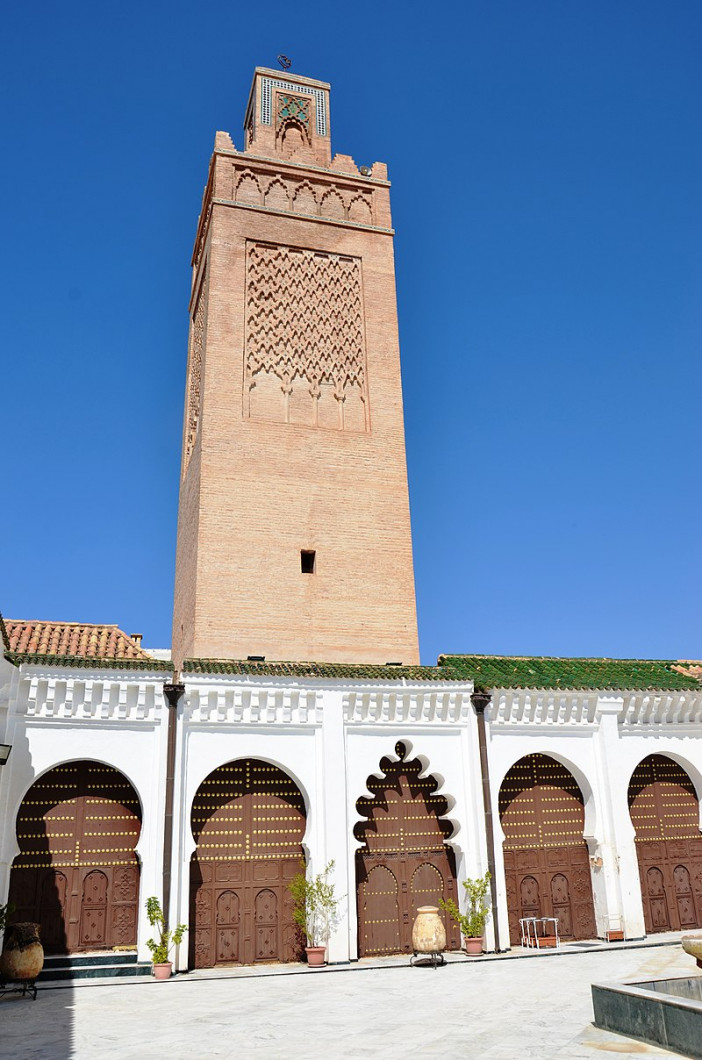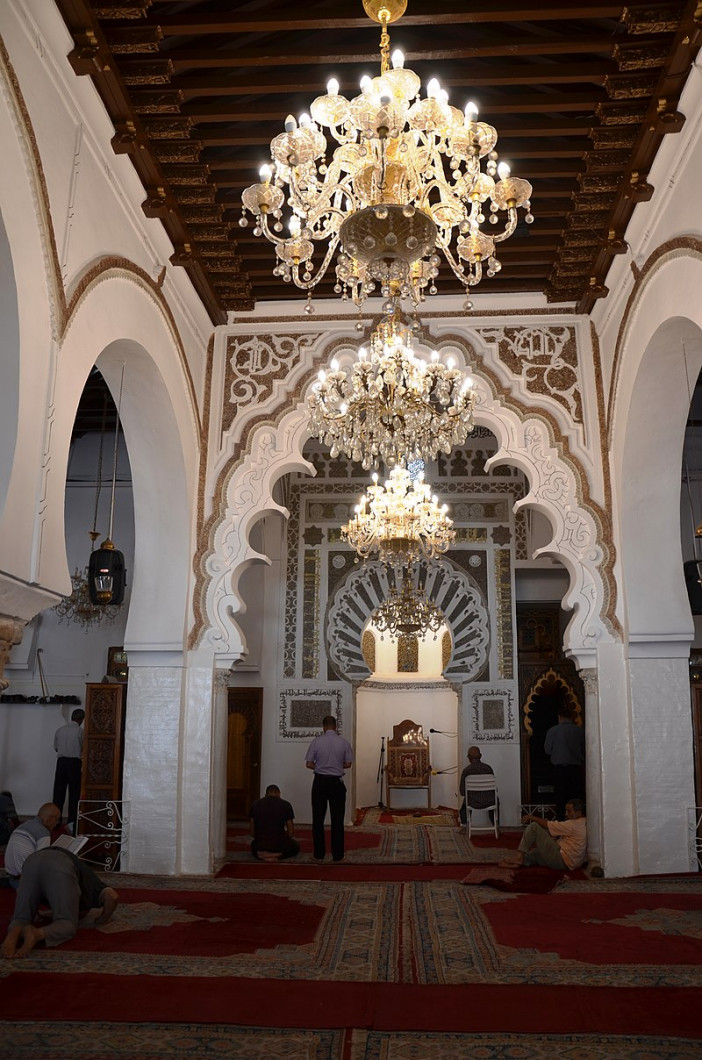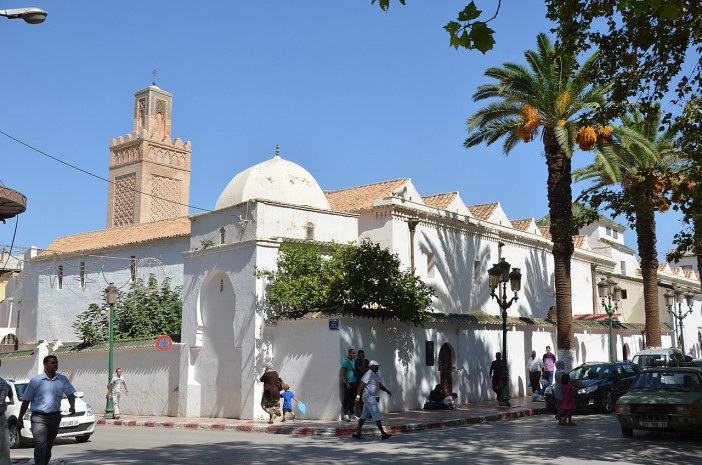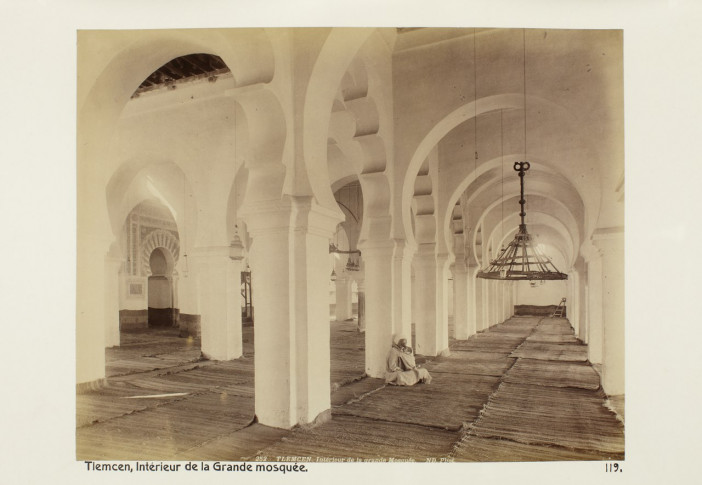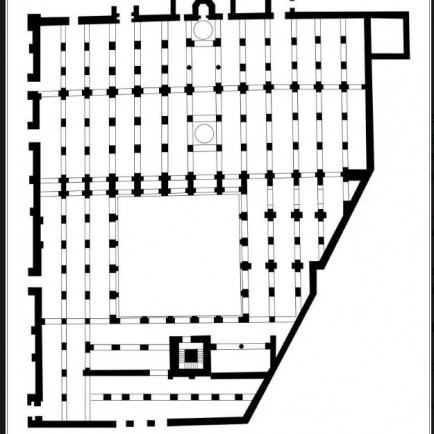Great Mosque of Tlemcen
History
When the Almoravid emir Yusuf ibn Tashfin expanded the Idrisid-era city of Agadir to become Tagrart (modern-day Tlemcen), he also erected the mosque. Ali ibn Yusuf, his son and successor, restored and embellished the mosque. The famed dome that is located next to the mosque's mihrab is among the items that come from this refurbishment, which according to an inscription underneath the dome was finished in 1136. Curiously, the real emir's name has been mysteriously removed from the inscription, maybe by the Almohads who succeeded the Almoravids as the city's rulers. The Qasr al-Qadima or Qasr al-Bali ("Old Palace"), the city's former Almoravid palace, is also thought to have bordered the mosque on its western side.
In 1236 Sultan Yaghmorasan (ruled 1236–1283), the founder of the Abdalwadid dynasty of Tlemcen, added the mosque's minaret near its courtyard. Yaghmorasan also modified the areas around the courtyard and extended the mosque structure northwards. The original mosque likely had a larger rectangular courtyard whose position and proportions would have been similar to the courtyards of earlier mosques in Al-Andalus, whereas Yaghmorasan's modifications left the mosque with a square courtyard whose middle axis is no longer aligned with the middle axis of the mosque. The less ornate dome in the middle of the prayer hall today probably also dates from this time.
An Islamic university and court (Mahkama) once stood next to the mosque. The mosque and other significant city landmarks were designated as "Historic Monuments" in 1875, under French colonial rule, and were subject to special preservation requirements. The mosque had its first contemporary restorations, studies, and repairs about the same period.
Urban and Architectural
The mosque's floor space measures roughly 50 by 60 meters (160 by 200 feet). [3][5] Despite having a normal rectangular floor plan, the mosque's northwest corner has been blunted due to the former existence of a palace on this side.It has an internal courtyard and a prayer hall in the hypostyle found in most mosques in North Africa (sahn). The 13 naves or aisles of the prayer hall are separated by 12 rows of horseshoe arches that run parallel to the wall of the southeast qibla.
Two transverse rows of arches – one on the south side of the courtyard and another roughly midway between the courtyard and the qibla wall – also include polylobed arches, and another polylobed arch runs transversally before the bay in front of the mihrab (niche indicating the direction of prayer) (niche symbolizing the direction of prayer). The center aisle is bigger than the other aisles and is located in front of the mihrab. The ornate ribbed dome at the center of this aisle, in front of the second row of transverse arches, was probably constructed by Yaghmorasan in the 13th century.
The bay in front of the mihrab is covered with an additional ornamental dome that is older and more complex. There are marble columns in several of the arch pillars near the mihrab.The mihrab itself is a wall alcove that is framed by intricately carved stucco decoration and opens through a horseshoe arch. The mihrab of the Great Mosque of Cordoba's mihrab serves as a general architectural model for the mihrab's overall design.
The intricately ribbed dome in front of the mihrab, which was renovated by Ali ibn Yusuf, is regarded as the pinnacle of Almoravid architecture. The dome's structure is entirely ornamental and is made up of several ribs or crossed arches that look like a 12-pointed star. Additionally, it has a screen of carved and perforated arabesque and openwork decoration that covers the crevices between the ribs, making it somewhat transparent and enabling some outside light to pass through.
The intricately ribbed dome in front of the mihrab, which was renovated by Ali ibn Yusuf, is regarded as the pinnacle of Almoravid architecture.The dome's structure is entirely ornamental and is made up of several ribs or crossed arches that look like a 12-pointed star. Additionally, it has a screen of carved and perforated arabesque and openwork decoration that covers the crevices between the ribs, making it somewhat transparent and enabling some outside light to pass through.
Observation of the mihrab and its surroundings
The current minaret was only erected in 1236 by Yaghmorasan, suggesting that the original Almoravid mosque was devoid of a minaret. The brick minaret has a standard square floor layout and is 6.3 meters (21 feet) on each side. It has a two-tiered shaft, with the primary shaft standing at 26.2 meters (86 feet) in height and an additional lantern tower bringing the overall height to 29.15 meters (95.6 feet). [7] Sebka designs are carved into panels that adorn the four faces of the main shaft of the minaret, which are supported by engaged columns below. The unevenness of the ornamental panel on the courtyard side, as well as the distance between the engaged columns on the opposite.
An interesting detail is the unevenness of the ornamental panel on the courtyard side. The sebka pattern above it is unevenly spaced because the engaged columns on the left have a bigger gap between them than the others.
Description
References
Almagro, Antonio (2015). "The Great Mosque of Tlemcen and the Dome of its Maqsura"
Marçais, Georges (1954). L'architecture musulmane d'Occident. Paris: Arts et métiers graphiques.
https://islamicart.museumwnf.org/database_item.php?id=monument;ISL;dz;Mon01;1;en
https://www.archnet.org/sites/14956
Details
Location
Tlemcen, Algeria
Drawings
Map
History
When the Almoravid emir Yusuf ibn Tashfin expanded the Idrisid-era city of Agadir to become Tagrart (modern-day Tlemcen), he also erected the mosque. Ali ibn Yusuf, his son and successor, restored and embellished the mosque. The famed dome that is located next to the mosque's mihrab is among the items that come from this refurbishment, which according to an inscription underneath the dome was finished in 1136. Curiously, the real emir's name has been mysteriously removed from the inscription, maybe by the Almohads who succeeded the Almoravids as the city's rulers. The Qasr al-Qadima or Qasr al-Bali ("Old Palace"), the city's former Almoravid palace, is also thought to have bordered the mosque on its western side.
In 1236 Sultan Yaghmorasan (ruled 1236–1283), the founder of the Abdalwadid dynasty of Tlemcen, added the mosque's minaret near its courtyard. Yaghmorasan also modified the areas around the courtyard and extended the mosque structure northwards. The original mosque likely had a larger rectangular courtyard whose position and proportions would have been similar to the courtyards of earlier mosques in Al-Andalus, whereas Yaghmorasan's modifications left the mosque with a square courtyard whose middle axis is no longer aligned with the middle axis of the mosque. The less ornate dome in the middle of the prayer hall today probably also dates from this time.
An Islamic university and court (Mahkama) once stood next to the mosque. The mosque and other significant city landmarks were designated as "Historic Monuments" in 1875, under French colonial rule, and were subject to special preservation requirements. The mosque had its first contemporary restorations, studies, and repairs about the same period.
Urban and Architectural
The mosque's floor space measures roughly 50 by 60 meters (160 by 200 feet). [3][5] Despite having a normal rectangular floor plan, the mosque's northwest corner has been blunted due to the former existence of a palace on this side.It has an internal courtyard and a prayer hall in the hypostyle found in most mosques in North Africa (sahn). The 13 naves or aisles of the prayer hall are separated by 12 rows of horseshoe arches that run parallel to the wall of the southeast qibla.
Two transverse rows of arches – one on the south side of the courtyard and another roughly midway between the courtyard and the qibla wall – also include polylobed arches, and another polylobed arch runs transversally before the bay in front of the mihrab (niche indicating the direction of prayer) (niche symbolizing the direction of prayer). The center aisle is bigger than the other aisles and is located in front of the mihrab. The ornate ribbed dome at the center of this aisle, in front of the second row of transverse arches, was probably constructed by Yaghmorasan in the 13th century.
The bay in front of the mihrab is covered with an additional ornamental dome that is older and more complex. There are marble columns in several of the arch pillars near the mihrab.The mihrab itself is a wall alcove that is framed by intricately carved stucco decoration and opens through a horseshoe arch. The mihrab of the Great Mosque of Cordoba's mihrab serves as a general architectural model for the mihrab's overall design.
The intricately ribbed dome in front of the mihrab, which was renovated by Ali ibn Yusuf, is regarded as the pinnacle of Almoravid architecture. The dome's structure is entirely ornamental and is made up of several ribs or crossed arches that look like a 12-pointed star. Additionally, it has a screen of carved and perforated arabesque and openwork decoration that covers the crevices between the ribs, making it somewhat transparent and enabling some outside light to pass through.
The intricately ribbed dome in front of the mihrab, which was renovated by Ali ibn Yusuf, is regarded as the pinnacle of Almoravid architecture.The dome's structure is entirely ornamental and is made up of several ribs or crossed arches that look like a 12-pointed star. Additionally, it has a screen of carved and perforated arabesque and openwork decoration that covers the crevices between the ribs, making it somewhat transparent and enabling some outside light to pass through.
Observation of the mihrab and its surroundings
The current minaret was only erected in 1236 by Yaghmorasan, suggesting that the original Almoravid mosque was devoid of a minaret. The brick minaret has a standard square floor layout and is 6.3 meters (21 feet) on each side. It has a two-tiered shaft, with the primary shaft standing at 26.2 meters (86 feet) in height and an additional lantern tower bringing the overall height to 29.15 meters (95.6 feet). [7] Sebka designs are carved into panels that adorn the four faces of the main shaft of the minaret, which are supported by engaged columns below. The unevenness of the ornamental panel on the courtyard side, as well as the distance between the engaged columns on the opposite.
An interesting detail is the unevenness of the ornamental panel on the courtyard side. The sebka pattern above it is unevenly spaced because the engaged columns on the left have a bigger gap between them than the others.
Description


